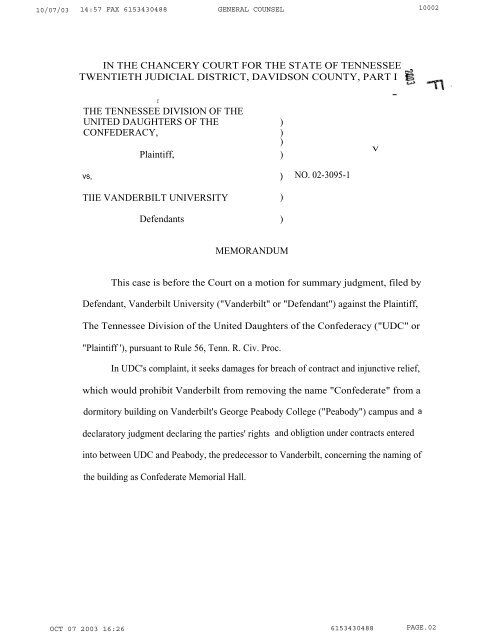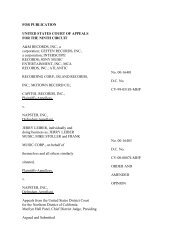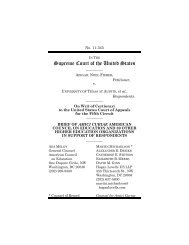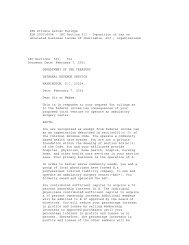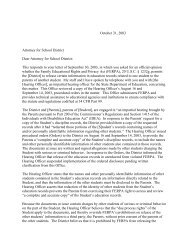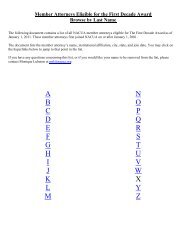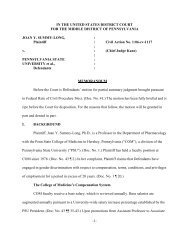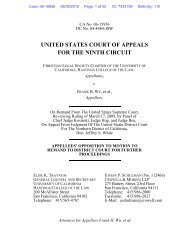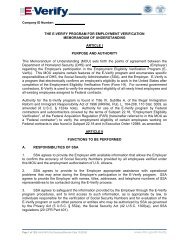The Tennessee Division of the United Daughters of the Confederacy ...
The Tennessee Division of the United Daughters of the Confederacy ...
The Tennessee Division of the United Daughters of the Confederacy ...
- No tags were found...
Create successful ePaper yourself
Turn your PDF publications into a flip-book with our unique Google optimized e-Paper software.
10/07/03 14:58 FAX 6153430488 GENERAL COUNSEL 10005(UDC Volume I Minutes, Appendix 4, Article II)(Emphasis Added).13. At its annual general convention in November, 1953, <strong>the</strong> UDC approved<strong>the</strong> development <strong>of</strong> a Catechism on <strong>the</strong> History <strong>of</strong> <strong>the</strong> Confederate States <strong>of</strong> America,which was first printed in October, 1954 and revised in 1999. (Deposition <strong>of</strong> JanetJohnston ("Johnston"), Ex. 5, Appendix 5).14. <strong>The</strong> stated purpose <strong>of</strong> that "Catechism" was to "teach <strong>the</strong> truths <strong>of</strong> ourConfederate history..." (Id.).15. In that Catechism, <strong>the</strong> following questions are addressed:Q. What causes led to <strong>the</strong> War Between <strong>the</strong> States? How was this shown?A. <strong>The</strong> disregard <strong>of</strong> those in power for <strong>the</strong> rights <strong>of</strong> <strong>the</strong> sou<strong>the</strong>rn states and by<strong>the</strong> passage <strong>of</strong> laws annulling <strong>the</strong> rights <strong>of</strong> <strong>the</strong> people (sic) <strong>the</strong> south.Q. What were <strong>the</strong>se rights?A. <strong>The</strong> right to regulate <strong>the</strong>ir own affairs, one <strong>of</strong> which was to hold slaves asproperty.Q. How were <strong>the</strong> slaves treated by <strong>the</strong>ir owners?A. <strong>The</strong> slaves, were treated, in most cases with kindness and care. Manyclaims '<strong>of</strong> cruelty and abuse were found to be <strong>the</strong> result <strong>of</strong> plantationoverseers.Q. What was <strong>the</strong> feeling <strong>of</strong> <strong>the</strong> slaves toward <strong>the</strong>ir masters?A. <strong>The</strong> slaves, for <strong>the</strong> most part, were faithful and devoted. Most slaves wereusually ready and willing to serve <strong>the</strong>ir masters.Q. How did <strong>the</strong> Slaves act during war?A. Many slaves protected and cared for <strong>the</strong> wives and families <strong>of</strong> <strong>the</strong> soldiersand continued to work on <strong>the</strong> plantations and farms. Though <strong>of</strong>tenprompted by enemies <strong>of</strong> <strong>the</strong> south to burn and plunder <strong>the</strong> homes <strong>of</strong> <strong>the</strong>irmasters, by far <strong>the</strong> great majority remained loyal.Did any blacks, free or slave, serve in <strong>the</strong> Confederate Army?A. Yes, it was originally thought that only body servants accompanying <strong>the</strong>irmasters actually fought, but later research indicates that many blacksjoined on <strong>the</strong>ir own when President Jefferson Davis -finally agreed <strong>the</strong>y4OCT 07 2003 16:27 6153430488 PAGE.05
10/07/03 15:00 FAX 6153430488 GENERAL COUNSEL008entered into by <strong>the</strong> parties; and <strong>the</strong>re shall be placed on said building an inscriptionnaming <strong>the</strong> building "Confederate Memorial." (Id.).34. <strong>The</strong> document fur<strong>the</strong>r provided "...that if, and when, [Peabody] secures<strong>the</strong> additional money from <strong>the</strong> National Recovery Administration, it will erect <strong>the</strong>building conformable to <strong>the</strong> plans and specifications approved by <strong>the</strong> parties, but if saidmoney is not secured from <strong>the</strong> National Recovery Administration, <strong>the</strong> building will beerected according to <strong>the</strong> terms <strong>of</strong> <strong>the</strong> contracts previously entered into between <strong>the</strong>parties; it being <strong>the</strong> intention <strong>of</strong> <strong>the</strong> parties that this contract shall be void and <strong>of</strong> no effectin case said money is not obtained from said National Recovery Administration. (Id.).35. Although Peabody attempted to obtain <strong>the</strong> $100,000 in funds from <strong>the</strong>National Recovery Administration, that request was denied on <strong>the</strong> grounds that Peabodywas not a "Public" institution. (Letter from E. H. Foley, Jr., Assistant General Counsel <strong>of</strong>Federal Energy Administration and Public Works to Mr. Bradley Walker, Esq., Appendix12).36. Despite Peabody's inability to obtain <strong>the</strong> funds from <strong>the</strong> NRA, <strong>the</strong>Executive Committee <strong>of</strong> Peabody authorized <strong>the</strong> borrowing <strong>of</strong> that amount from <strong>the</strong>College's endowment funds in order to build <strong>the</strong> dormitory. (Minutes <strong>of</strong> Board <strong>of</strong>Trustees Meeting <strong>of</strong> June 8, 1934, Appendix 13).37. Only July 12th, 1934, <strong>the</strong> Peabody Executive Committee awarded <strong>the</strong> contractfor <strong>the</strong> construction <strong>of</strong> "Confederate Memorial Dormitory. . . at a guaranteed upset price <strong>of</strong>$131,294, or less." (July 12, 1934 Contract Award, Appendix 14).38. <strong>The</strong> building was completed in 1935 and apparently administeredaccording to <strong>the</strong> terms <strong>of</strong> <strong>the</strong> 1927 agreement between Peabody and <strong>the</strong> UDC until <strong>the</strong>late 1970's.39. In 1978, Vanderbilt entered into a lease with Peabody, which provided fortwo <strong>of</strong> <strong>the</strong> Peabody dormitories, including <strong>the</strong> building known as Confederate MemorialHall to be utilized by Vanderbilt students. (Deposition <strong>of</strong> Stephen A. Caldwell("Caldwell") Deposition Excerpts, pp. 14-15, Appendix 15).40. In April, 1978, when <strong>the</strong> Plaintiff UDC learned that <strong>the</strong> dormitory was tobe leased to Vanderbilt by Peabody, Ms. Mary Sneed Jones, Chairman <strong>of</strong> <strong>the</strong> ConfederateMemorial Hall Committee, write to Dr. John Dunworth, President<strong>of</strong> Peabody, to askwhat were <strong>the</strong> plans for "room awards" to be given to young women nominated by <strong>the</strong>UDC and what would be <strong>the</strong> disposition <strong>of</strong> various furnishings, portraits, etc., and "o<strong>the</strong>rConfederate items." (Johnson, Ex. 6, Appendix 16).41. Ms. Sneed suggested that Peabody lease ano<strong>the</strong>r dormitory to Vanderbilt. (Id.).7OCT 07 2003 16:296153430488 PAGE.08
42. Dr. Dunworth responded by returning to <strong>the</strong> UDC various items, whichwere apparently donated to <strong>the</strong> <strong>Tennessee</strong> State Museum. (Johnson, Ex. 7, Appendix 17).43. Once Vanderbilt began utilizing <strong>the</strong> building for its students, no more thanfour students designated by <strong>the</strong> UDC for reduced cost rent remained in <strong>the</strong> dormitory andafter <strong>the</strong>y graduatcd, no students were housed in that building in accordance with <strong>the</strong>original purpose <strong>of</strong> <strong>the</strong> building's construction. (Caldwell, pp. 15-16, Appendix 15).44. In 1979, Vanderbilt acquired Peabody through a merger agreement underwhich Peabody became a part <strong>of</strong> Vanderbilt, with Vanderbilt as <strong>the</strong> surviving entity.(Defendant's Response to Request for Production <strong>of</strong> Documents, Attachment I,Appendix 18).45. At <strong>the</strong> time Vanderbilt acquired <strong>the</strong> Peabody campus, most <strong>of</strong> <strong>the</strong> Peabodybuildings had fallen into disrepair and were in need <strong>of</strong> significant maintenance andmodernization to meet <strong>the</strong>n current building and safety codes. (Affidavit <strong>of</strong> JudsonNewberry Paragraph 2a, Appendix 19).46. In 1987 and 1988, Vanderbilt expended approximately Four Million NineHundred Thousand ($4,900,000.00) Dollars refurbishing Confederate Hall and East Halldormitories. (Id.).47. Approximately $2.5 million was spend on Confederate Hall alone. (Id_).48. No money was contributed by <strong>the</strong> UDC to <strong>the</strong> maintenance or renovation<strong>of</strong> <strong>the</strong> building after its initial construction in 1934. (Johnson, pp. 34-35, Appendix 15).49. Following integration <strong>of</strong> <strong>the</strong> Vanderbilt student body in <strong>the</strong> 1960's,throughout <strong>the</strong> 1970's and 1980's, <strong>the</strong> University began to increase its efforts to recruitminority students and faculty members. (Affidavit <strong>of</strong> Pat Pierce, Appendix 20).50. In <strong>the</strong> 1988-1989 academic year, <strong>the</strong> propriety <strong>of</strong> maintaining <strong>the</strong> name"Confederate Hall" was discussed by various student groups, including <strong>the</strong> RacialEnvironment Project and Interhall, a representative organization <strong>of</strong> students who live inUniversity .residence halls. (Wyatt pp. 8, 16, Appendix 15).51. In <strong>the</strong> spring <strong>of</strong> 1989, Vanderbilt's Student Govermnent Association("SGA") passed a resolution recommending <strong>the</strong> installation <strong>of</strong> a plaque on <strong>the</strong> building"designed to explain why <strong>the</strong> building is "Confederate." Pursuant to that resolution, acommemorative plaque was designed and installed on <strong>the</strong> building in December <strong>of</strong> 1989.(Wyatt pp. 8. 16, Caldwell, p. 18, Appendix 15; and 1989 memo regarding plaque,Appendix 21).52. That plaque remains on <strong>the</strong> building and Vanderbilt has expressed nointention to remove that plaque. (Id.).8
53. Vanderbilt has conntinued its efforts to recruit minority students, includingAfrican-American students, to <strong>the</strong> present, increasing its African-Americanundergraduate student enrollment to 371 in <strong>the</strong> 2002-03 academic year. (Pierce Affidavit).54. In March, 2000, <strong>the</strong> Vanderbilt SGA passed a resolution recommendingthat <strong>the</strong> name <strong>of</strong> Confederate Hall be changed because "regardless <strong>of</strong> <strong>the</strong> original intent<strong>of</strong> <strong>the</strong> <strong>United</strong> <strong>Daughters</strong> <strong>of</strong> <strong>the</strong> <strong>Confederacy</strong> in 1935, individuals at Vanderbilt Universityfeel <strong>of</strong>fended by <strong>the</strong> name <strong>of</strong> <strong>the</strong> residence facility..., <strong>the</strong> demographic population atVanderbilt University has significantly changed since 1935..., and Vanderbilt Universityis an institution committed to respecting all individuals regardless <strong>of</strong> <strong>the</strong>ir racial identity."(Defendant's Response to Plaintiffs First Request for Production <strong>of</strong> Documents,Attachment H (Appendix 18)).55. In October, 2002, <strong>the</strong> SGA passed a second resolution, again supporting<strong>the</strong> change <strong>of</strong> <strong>the</strong> name <strong>of</strong> Confederate Memorial Hall since "...members <strong>of</strong> <strong>the</strong>community have resolved not to live in Confederate Memorial Hall..., VanderbiltUniversity should strive to be a place in which all students are challenged but notexcluded from feeling a part <strong>of</strong> <strong>the</strong>ir campus and <strong>the</strong>ir dorms, ...Vanderbilt University isnot proud <strong>of</strong> <strong>the</strong> legacy <strong>of</strong> slavery that is attached to <strong>the</strong> name <strong>of</strong> Confederate MemorialHall or <strong>of</strong> some <strong>of</strong> <strong>the</strong> actions <strong>of</strong> <strong>the</strong> <strong>United</strong> <strong>Daughters</strong> <strong>of</strong> <strong>the</strong> <strong>Confederacy</strong>..." (Id.,Appendix 18).56. In February, 2000, Dr. E. Gordon Gee was named Chancellor <strong>of</strong>Vanderbilt. (Gee Depo. P. 20).57. Soon after assuming his duties in July, 2000, Dr. Gee began to hearcomplaints from students, prospective students, faculty members and prospective facultymembers regarding <strong>the</strong> maintenance <strong>of</strong> <strong>the</strong> building designated as "ConfederateMemorial Hall" on <strong>the</strong> University's campus as being contrary to <strong>the</strong> University's statedgoals and ideals <strong>of</strong> racial diversity. (Gee Depo. Pp. 55-51, Appendix 15).58. In <strong>the</strong> summer <strong>of</strong> 2002, Dr. Gee, in consultation with <strong>the</strong> seniormanagement <strong>of</strong>ficials <strong>of</strong> <strong>the</strong> University, made <strong>the</strong> decision to change <strong>the</strong> name <strong>of</strong> <strong>the</strong>building and received support <strong>of</strong> <strong>the</strong> Executive Committee <strong>of</strong> <strong>the</strong> Board to carry out thataction. (Gee Depo. Pp. 25-30, Appendix 15).59. In a memorandum to <strong>the</strong> University's Board <strong>of</strong> Trustees in October, 2002.Dr. Gee explained his action as follows:As trivial as it may sound on first blush, <strong>the</strong> presence <strong>of</strong> a building named"Confederate Memorial Hall" has been identified by former, current andprospective students, faculty, staff and friends as one <strong>of</strong> <strong>the</strong> barriers toachieving <strong>the</strong> kind <strong>of</strong> inclusive and welcoming environment that isessential for a world-class university. This has come through consistentlyover <strong>the</strong> past 14 years, ever since <strong>the</strong> controversy first surfaced when <strong>the</strong>9
esidence hall was renovated. A number <strong>of</strong> students, faculty and staff hasrefused to live or attend events in <strong>the</strong> building, and <strong>the</strong>y marveled (not in apositive way) that our campus was being used to commemorate a systemthat, however noble <strong>the</strong> intention, had come to stand for values that werenot consistent with Vanderbilt's beliefs and ethos.Simply put, <strong>the</strong> name <strong>of</strong> a building, and this building in particular, is ablunt instrument. It carries with it no footnote, no explanation <strong>of</strong> <strong>the</strong>circumstances <strong>of</strong> its construction-which itself was intended by <strong>the</strong> UDCto recognize a certain version <strong>of</strong> history. <strong>The</strong> original name <strong>of</strong> <strong>the</strong>building was established at a different time in history to commemoratevalues that do not reflect those <strong>of</strong> a university dedicated to educating alland meeting <strong>the</strong> aspirations <strong>of</strong> our broadest society. Students wereassigned to live in a building that many believed stood in opposition to <strong>the</strong>University's core values. It implied an endorsement, if not a celebration,<strong>of</strong> a system that is at <strong>the</strong> very lease <strong>of</strong>fensive to many people.That we shall have a building on our campus whose very name givesactive <strong>of</strong>fenses to a cross-section <strong>of</strong> people from around <strong>the</strong> world istroubling, to say <strong>the</strong> least. And, I should add, it strongly reinforces_ <strong>the</strong>worst stereotypes, still held by too many regardless <strong>of</strong> <strong>the</strong>ir geography, <strong>of</strong>Vanderbilt as an institution trapped in a long-distant past.(Gee Depo., Ex. 3) (emphasis added).60. In <strong>the</strong> fall <strong>of</strong> 2002, <strong>the</strong> Plaintiff was advised <strong>of</strong> <strong>the</strong> University's decisionregarding <strong>the</strong> name <strong>of</strong> <strong>the</strong> Building. (Gee Depo. p. 70, Appendix 15; Ex. 15, Appendix22).61. Representatives <strong>of</strong> <strong>the</strong> University and <strong>the</strong> Plaintiff met on at least twooccasions to discuss a possible resolution <strong>of</strong> <strong>the</strong> name change including o<strong>the</strong>r possiblenames for <strong>the</strong> building. (Gee Depo. O. 74-75, Appendix 15).62. Fur<strong>the</strong>r discussion between <strong>the</strong> parties ended when this action was filed.63. As <strong>of</strong> this date, <strong>the</strong> stone engraving on <strong>the</strong> building remains, as does <strong>the</strong>plaque describing <strong>the</strong> history <strong>of</strong> <strong>the</strong> building, which was placed on <strong>the</strong> building in 1989.(Caldwell Depo. P. 10, Appendix 15).64. <strong>The</strong> University has changed <strong>the</strong> name <strong>of</strong> <strong>the</strong> building on University maps,and on its website, and it is now referred to as "Memorial Hall." (Id.).10
Under <strong>the</strong> provisions <strong>of</strong> Rule 56.04, Tenn. Rules <strong>of</strong> Civ. Proc., <strong>the</strong> summaryjudgment sought shall be granted, "if <strong>the</strong> pleadings, depositions, answers tointerrgatories, and admissions on file, toge<strong>the</strong>r with <strong>the</strong> affidavits, if any, show that<strong>the</strong>re is no genuine issue as to any material fact and that <strong>the</strong> moving party is entitled to ajudgment as a matter <strong>of</strong> law."In Byrd v Hall , 847 S.W.2d 208 (Tenn. 1993), <strong>The</strong> <strong>Tennessee</strong> Supreme Courtmade a finding that <strong>the</strong> issues that lay at <strong>the</strong> heart <strong>of</strong> evaluating a summary judgmentmotion are: (1) whe<strong>the</strong>r a factual dispute exists; (2) whe<strong>the</strong>r a disputed fact is material to<strong>the</strong> outcome <strong>of</strong> <strong>the</strong> case; and (3) whe<strong>the</strong>r <strong>the</strong> disputed fact creates a genuine issue fortrial. Id. at 214.<strong>The</strong> issue presented to <strong>the</strong> Court, whe<strong>the</strong>r Vanderbilt has shown a sufficient basisfor modification <strong>of</strong> <strong>the</strong> parties' contracts to allow Vanderbilt to remove <strong>the</strong> name,"Confederate" from <strong>the</strong> building on Vanderbilt's Peabody campus. <strong>The</strong> answer to thisquestion is yes.A.UDC opposes <strong>the</strong> motion for summary judgment and argues that Vanderbilt hasnot shown a legal basis for modification <strong>of</strong> <strong>the</strong> contracts to name <strong>the</strong> building, "MemorialHall".UDC relies on <strong>the</strong> contracts between <strong>the</strong> parties. However, <strong>the</strong> 1913 and 1927contracts do not require Peabody to name <strong>the</strong> building, "Confederate Memorial Hall'".
<strong>The</strong> 1933 contract requires Peabody to name <strong>the</strong> building, "Confederate Memorial Hall."However, <strong>the</strong> Court finds <strong>the</strong> 1933 contract to be null and void, because <strong>the</strong> conditionprecedent <strong>of</strong> Peabody obtaining a construction loan from <strong>the</strong> National RecoveryAdministration never occurred.However, <strong>the</strong> course <strong>of</strong> dealing between <strong>the</strong> parties persuades <strong>the</strong> Court toconclude that it was <strong>the</strong> intention <strong>of</strong> <strong>the</strong> parties that <strong>the</strong> building would be named"Confederate Memorial Hall."B.When UDC and Peabody entered into <strong>the</strong> contracts for <strong>the</strong> construction <strong>of</strong> <strong>the</strong>dormitory building, segregation based on race was legal and practiced in <strong>the</strong> sou<strong>the</strong>rnstates <strong>of</strong> America.Now racial segregation has been declared illegal, because <strong>of</strong> <strong>the</strong>passage <strong>of</strong> federal civil rights acts and decisions <strong>of</strong> <strong>the</strong> <strong>United</strong> States Supreme Court.When UDC and Peabody executed <strong>the</strong> contracts, <strong>the</strong>y apparently did not realizethat public policy, on race would change and that discrimination against minorities,i ncluding African-Americans, would be against <strong>the</strong> law and fur<strong>the</strong>r, that a stigma wouldbe attached to <strong>the</strong> name "<strong>Confederacy</strong>" because <strong>of</strong> its relationship to <strong>the</strong> institution <strong>of</strong>slavery.C.In <strong>the</strong> 1960's, Vanderbilt integrated its student body and now it has approximately371 minority students. Vanderbilt seeks to achieve diversity in its faculty and studentbody.<strong>The</strong> name "Confederate" on its building with <strong>the</strong> stigma <strong>of</strong> <strong>the</strong> institution <strong>of</strong>slavery, is in contradiction <strong>of</strong> its policy <strong>of</strong> diversity and makes it extremely difficult torecruit minority faculty members and minority students. It is impractical and unduly12
urdensome for Vanderbilt to continue to perform that part <strong>of</strong> <strong>the</strong> contract pertaining to<strong>the</strong> maintenance <strong>of</strong> <strong>the</strong> name "Confederate" on <strong>the</strong> building, and at <strong>the</strong> same time pursueits academic purpose <strong>of</strong> obtaining a racially diverse faculty and student body.D.UDC argues that Vanderbilt's Chancellor Gee lacked authority from Vanderbilt<strong>of</strong>ficials to remove <strong>the</strong> name "Confederate" from <strong>the</strong> building. However. <strong>the</strong> Court findsthis argument without merit.V.<strong>The</strong> Court finds that Vanderbilt carried its burden <strong>of</strong> pro<strong>of</strong> for modification <strong>of</strong> <strong>the</strong>contracts. <strong>The</strong>refore, <strong>the</strong> Court makes <strong>the</strong> follow declaration:(a)Vanderbilt sufficiently complied with its obligations to UDC under <strong>the</strong>contracts <strong>of</strong> <strong>the</strong> years 1913 and 1927 by <strong>the</strong> installation and maintenance <strong>of</strong> <strong>the</strong> plaque on<strong>the</strong> Peabody building which explains <strong>the</strong> history <strong>of</strong> <strong>the</strong> construction <strong>of</strong> <strong>the</strong> building.(b)Vanderbilt may remove <strong>the</strong> name "Confederate" from <strong>the</strong> building withoutany fur<strong>the</strong>r obligations to UDC, o<strong>the</strong>r than to maintain <strong>the</strong> said plaque on <strong>the</strong> building.Vl.In conclusion, <strong>the</strong> Court finds that Vanderbilt's motion for summary judgmentshall be granted.UDC's request for partial summary judgment is denied.In view <strong>of</strong> <strong>the</strong> foregoing, <strong>the</strong> Court finds it unnecessary to consider o<strong>the</strong>r issuesraised by <strong>the</strong> parties.UDC's complaint is dismissed.<strong>The</strong> costs are taxed one-half (1/2) to UDC and one-half (1/2) to Vanderbilt.13
Memorandum.<strong>The</strong> attorneys for Vanderbilt shall prepare an order consistent with thislrvin H. Kilcrease, Jr.ChancellorSeptember 29, 2003cc:Douglas E. Jones, Esq.Robert J. Notestine, Esq.Bill Ozier, Esq.Leona Marx Esq.RULE 58 CER,, : -,, ,, _,jA Copy <strong>of</strong> this order has been served by U. S. Mailupon all parties or <strong>the</strong>ir counsel named above.Deputy Clerk and MasterChancery CourtDate14


